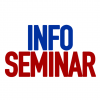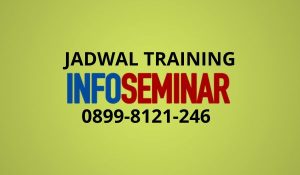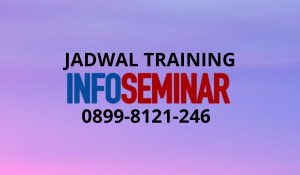Business Process Architechture Course Outline (JAKARTA)
Jakarta, 2 November 2015 – 4 November 2015
Including : Souvenir, Flash disk, materi hand-out dan CD modul, 2x coffee break, makan siang dan sertifikat
Description
What does Business Architecture mean to your organization? How do you enable it to create value for the organization? What pieces need to be in place to ensure its success? What skills and techniques need to accompany a successful BA effort? An organization’s business model, goals, organizational structure and other constraints need to be considered when looking at how business architecture can become a value-added, business-focused discipline within the organization.
The above questions and many others need to be carefully considered while embarking on the journey of creating a business architecture within your organization.
This one-day overview course addresses these questions and considerations by discussing business architecture fundamentals and the array of different ways that today’s organizations are moving ahead with their Business Process Architechture efforts.
Objectives
- Define Business Architecture and its benefits
- Identify and define the important dimensions that make up a Business Process Architecture
- Present modeling techniques used in the three dimensions of Business Process architecture
- Discuss the different approaches organizations have for their Business Process Architecture initiatives
- Review the organizational considerations when applying Business Process Architecture
- Address the relationship among business process and the critical success factors
- Understand how to tailor a Business Architecture for multiple purposes including business transformation and business improvement
- Identify the appropriate use of tools to support Business Process Architecture
Target Audience
- Application Developer
- Application / software Designer
- Application integration engineer
- Functional Specialist
- MIS Manager
- Project Manager
- Managers seeking to improve business process productivity through IT and Enterprise Architechture implementation
- Decision makers involved in developing and evaluating strategic IT plans
- Executives involved in the management and governance of IT resources
- IT practitioners wishing to enhance their knowledge of strategic infrastructure implementation
Duration : 3 days
Course Contents
What is Enterprise/Information Technology Architecture (EA)?
- EA/ IT Architechture Definition
- The Enterprise/ Information Technology Architecture Domain
- EA Vision and Benefits
- EA Segments
- EA Frameworks and Selection Principles
- EA Interfaces
- EA Governance
- EA Products
- EA Implementation Strategy
- EA Domains
- Business drivers for Enterprise Architecture
- Key Issues for EA
- EA implementation essentials
· Strategies, architectures, models, skills, approaches and tools
· Developing and managing an EA
· EA Budget Allocation and Roles
· EA Performance Measurement
· EA Budget / Performance Integration
· Component-Based Architectures
· Enterprise Architecture (EA) Choices
· TOGAF, Zachman Framework (ZF) and RUP/EUP, Spewak’s EAP, DoDAF, MODAF, AGATE, and FEAF
- Current State and Future Directions of the IT Industry
- The IT Challenge
- Alignment of IT to Business
- Rols of EA
- IT Strategic Planning
- IT Program and Portfolio Management
- IT Development vs. Operations
- SDLC
- ITIL/ITSM
- IT Governance
- Regulatory and Compliance (SOX)
- COBIT
- COSO
- IT Infrastructure Architecture Domains
- Integrated Architecture Framework
- Architecture and Architecture Framework Defined
- Trends in IT
- Social Networking
- Web 2.0/Mashups/Wiki/Widgetization
- Enterprise 2.0
- Virtualization
- SOA
- Green Computing
EA Components
- Application and Technology Architecture
- Conceptual, Logical, and Physical Views
- Application Architecture
- Application Patterns
- Technology Architecture
- Technology Patterns
- Business Architecture
- Information Architecture
- Data Architecture
- Systems Architecture
- Systems Management
- Privacy
- Security and Directory
- Capacity Planning
- Disaster Recovery
- Computer Architecture
- The Business Architecture
- Access Architecture
- Integration Architecture
- Network Architecture
- Platform Architecture
EA Implementation Plan Examples
- EA Planning, Acquisition and Requirements Generation
- Strategies for EA Management
- Implementing EA Strategies
- Integration of EA, Security, and Capital Planning Processes
- Building Support for EA Across Independent Organizations
- Using the EA to Assess and Improve Performance
- Using the EA to Make Intelligent Management Decisions
- Tactical Issues for Applying EA Investments
- Designing an EA for Business Value and Relevance
- The Change Management Challenge of Implementing a Successful EA Program
- Lessons Learned from EA Implementations
- Architecture and Transformation
- Essential Elements for Creating a Usable Enterprise Architecture
A Comparison of the Top Enterprise-Architecture Methodologies
- Using the Enterprise Architecture to Quantify the Benefits of IT Projects
- The Zachman Framework (ZF) for Enterprise Architecture
- Using the Zachman Framework to Integrate Security and EA
- Enterprise knowledge artifacts
- Extended framework
- Rules of the Framework
- The Open Group Architectural Framework (TOGAF)
- Architecture Development Method (ADM)
- Enterprise Continuum
- Federal Enterprise Architecture Framework (FEAF)
- The Rational Unified Process (RUP) and Enterprise Unified Process (EUP)
- Spewak’s EAP
- Department of Defense Architecture Framework (DoDAF) v1.5 and v2
- All View (AV)
- Operational View (OV)
- Systems View (SV)
- Technical Standards View (TV)
- DoDAF v2 Views and DoDAF Metamodel
- Nato Architecture Framework (NAF)
- The UK Ministry of Defence Architectural Framework (MODAF)
- Strategic goals of the enterprise, and the people, processes and systems
- AGATE, A framework by French government agency-Délégation Générale pour l’Armement (DGA)
- AGATE (Atelier de Gestion de l’ArchiTEcture des systèmes d’information et de communication)
- Stakes, Objectives, and context about the system
- Business architecture: describes organizations and Business processes
- Service-oriented architecture (SOA)
- Logical architecture of the system
- Physical architecture of the systems
- Hardware and software products used in the architecture
- EAI, BPM, SOA, and Web Services to Support Your Enterprise Architecture
Case Studies
- The Governance Enterprise Architecture (GEA)
- Definition and Motivation
- GEA models
- GEA Implementation directions
- e-Government development
- Establishment of appropriate EA governance processes
- EA Governance and EA Program Management
- EA Change Management and EA Deployment
- Usage milestones map to the enterprise assessment Criteria
- Cost Savings and Cost Avoidance
- Transition Strategy Performance
- Measuring EA Program Value
- Development and execution of EA value measurement plan to demonstrate the value of enterprise architecture (EA) in achieving enterprise objectives
- Implementing an Enterprise Architecture Program
Enterprise Architecture (EA) Exercises
- EA Selection Principles
- EA Implementation Templates
- EA Implementation Checklist
- EA Gap Analysis
- EA Case Studies
Cases
This part of the training shall divulge and highlight to the participants practical and particular cases related to the subject of good asset recovery management.
Trainer : Dr. Ir. Fauzi Hasan, MM, MBA
Dr. Fauzi Hasan Pada saat ini adalah President American Academy untuk Chapter Indonesia yang melingkupi American Academy of Project Management dan American Academy of Finance Management yang berpusasat di Colorado Spring, Colorado USA.
Pengalaman Dr. Fauzi Hasan diperkaya dengan keterlibatannya pada beberapa proyek terkait Business Process Modeling dan Improvement yang selaras dengan standard dan metodologi CMMI (Capability Maturity Model and Integration), dimana dalam akhir dekade ini banyak membantu organisasi Pemerintah dan Bank dalam membangun dan mengimplementasi Crisis Management Strategy seperti pembuatan BCP (Business Continuity Plan) dan DRP (Disaster Recovery Plan).
Dr. Fauzi Hasan telah memberikan kontribusi langsung untuk penyelesaian dan keberhasilan penerapan Frameworks dan Best Practices seperti: ITIL, COBIT, PMBOK, Prince2, TOGAF, ISO 20000, ISO 27000, ISO 38500, COSO dan yang lain diberbagai bidang industri. Sebagai seorang profesioal yang kompeten di bidang teknologi informasi, manajemen proyek dan proses bisnis ini dibuktikan dengan dimilikinya sejumlah sertifikat Internasional terkait tata kelola teknologi informasi dan industri (IT and Industrial Goverannce).
Dr. Fauzi Hasan dalam karirnya sebagai executive telah bekerja di beberapa perusahaan lokal maupun internasional seperti: Philips Netherlands, Sony , Warner Lambert, Singapore Technology Logistics, Hewlett-Packard, EMTEK Group, Intergraph, Jatis eCom-Sumitomo Group, dan ERESHA Group.
Investasi : Rp 5.000.000,- termasuk ( Souvenir, Flash disk, materi hand-out dan CD modul, 2x coffee break, makan siang dan sertifikat )
Tempat : Hotel Harris Tebet, Jl. Dr. Sahardjo No. 191 – Jakarta Selatan








